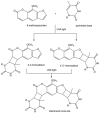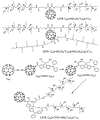Oxygen-Independent Antimicrobial Photoinactivation: Type III Photochemical Mechanism?
- PMID: 32023978
- PMCID: PMC7168166
- DOI: 10.3390/antibiotics9020053
Oxygen-Independent Antimicrobial Photoinactivation: Type III Photochemical Mechanism?
Abstract
Since the early work of the 1900s it has been axiomatic that photodynamic action requires the presence of sufficient ambient oxygen. The Type I photochemical pathway involves electron transfer reactions leading to the production of reactive oxygen species (superoxide, hydrogen peroxide, and hydroxyl radicals), while the Type II pathway involves energy transfer from the PS (photosensitizer) triplet state, leading to production of reactive singlet oxygen. The purpose of the present review is to highlight the possibility of oxygen-independent photoinactivation leading to the killing of pathogenic bacteria, which may be termed the "Type III photochemical pathway". Psoralens can be photoactivated by ultraviolet A (UVA) light to produce DNA monoadducts and inter-strand cross-links that kill bacteria and may actually be more effective in the absence of oxygen. Tetracyclines can function as light-activated antibiotics, working by a mixture of oxygen-dependent and oxygen independent pathways. Again, covalent adducts may be formed in bacterial ribosomes. Antimicrobial photodynamic inactivation can be potentiated by addition of several different inorganic salts, and in the case of potassium iodide and sodium azide, bacterial killing can be achieved in the absence of oxygen. The proposed mechanism involves photoinduced electron transfer that produces reactive inorganic radicals. These new approaches might be useful to treat anaerobic infections or infections in hypoxic tissue.
Keywords: antimicrobial photodynamic inactivation; bacteria; oxygen-independent photoinactivation; potassium iodide; psoralens; sodium azide; tetracyclines.
Conflict of interest statement
M.R.H. declares the following potential conflicts of interest. Scientific Advisory Boards: Transdermal Cap Inc, Cleveland, OH; BeWell Global Inc, Wan Chai, Hong Kong; Hologenix Inc. Santa Monica, CA; LumiThera Inc, Poulsbo, WA; Vielight, Toronto, Canada; Bright Photomedicine, Sao Paulo, Brazil; Quantum Dynamics LLC, Cambridge, MA; Global Photon Inc, Bee Cave, TX; Medical Coherence, Boston MA; NeuroThera, Newark DE; JOOVV Inc, Minneapolis-St. Paul MN; AIRx Medical, Pleasanton CA; FIR Industries, Inc. Ramsey, NJ; UVLRx Therapeutics, Oldsmar, FL; Ultralux UV Inc, Lansing MI; Illumiheal & Petthera, Shoreline, WA; MB Lasertherapy, Houston, TX; ARRC LED, San Clemente, CA; Varuna Biomedical Corp. Incline Village, NV; Niraxx Light Therapeutics, Inc, Boston, MA. Consulting; Lexington Int, Boca Raton, FL; USHIO Corp, Japan; Merck KGaA, Darmstadt, Germany; Philips Electronics Nederland B.V. Eindhoven, Netherlands; Johnson & Johnson Inc, Philadelphia, PA; Sanofi-Aventis Deutschland GmbH, Frankfurt am Main, Germany. Stockholdings: Global Photon Inc, Bee Cave, TX; Mitonix, Newark, DE.
Figures









Similar articles
-
Antimicrobial photodynamic inactivation with decacationic functionalized fullerenes: oxygen-independent photokilling in presence of azide and new mechanistic insights.Free Radic Biol Med. 2015 Feb;79:14-27. doi: 10.1016/j.freeradbiomed.2014.10.514. Epub 2014 Nov 10. Free Radic Biol Med. 2015. PMID: 25451642 Free PMC article.
-
Inorganic Salts and Antimicrobial Photodynamic Therapy: Mechanistic Conundrums?Molecules. 2018 Dec 3;23(12):3190. doi: 10.3390/molecules23123190. Molecules. 2018. PMID: 30514001 Free PMC article. Review.
-
Antimicrobial Photodynamic Inactivation Mediated by Tetracyclines in Vitro and in Vivo: Photochemical Mechanisms and Potentiation by Potassium Iodide.Sci Rep. 2018 Nov 20;8(1):17130. doi: 10.1038/s41598-018-35594-y. Sci Rep. 2018. PMID: 30459451 Free PMC article.
-
Potentiation of antimicrobial photodynamic inactivation by inorganic salts.Expert Rev Anti Infect Ther. 2017 Nov;15(11):1059-1069. doi: 10.1080/14787210.2017.1397512. Epub 2017 Oct 31. Expert Rev Anti Infect Ther. 2017. PMID: 29084463 Free PMC article. Review.
-
Advances in antimicrobial photodynamic inactivation at the nanoscale.Nanophotonics. 2017 Aug;6(5):853-879. doi: 10.1515/nanoph-2016-0189. Epub 2017 Aug 1. Nanophotonics. 2017. PMID: 29226063 Free PMC article.
Cited by
-
Photodynamic Activity of Chlorophyllin and Polyethylenimine on Pseudomonas aeruginosa Planktonic, Biofilm and Persister Cells.Int J Mol Sci. 2023 Jul 28;24(15):12098. doi: 10.3390/ijms241512098. Int J Mol Sci. 2023. PMID: 37569471 Free PMC article.
-
Photo-Antibacterial Activity of Two-Dimensional (2D)-Based Hybrid Materials: Effective Treatment Strategy for Controlling Bacterial Infection.Antibiotics (Basel). 2023 Feb 16;12(2):398. doi: 10.3390/antibiotics12020398. Antibiotics (Basel). 2023. PMID: 36830308 Free PMC article. Review.
-
The Application of Porphyrins and Their Analogues for Inactivation of Viruses.Molecules. 2020 Sep 23;25(19):4368. doi: 10.3390/molecules25194368. Molecules. 2020. PMID: 32977525 Free PMC article. Review.
-
Clinical applications of antimicrobial photodynamic therapy in dentistry.Front Microbiol. 2023 Jan 5;13:1020995. doi: 10.3389/fmicb.2022.1020995. eCollection 2022. Front Microbiol. 2023. PMID: 36687594 Free PMC article. Review.
-
Antimicrobial Photodynamic Therapy: Latest Developments with a Focus on Combinatory Strategies.Pharmaceutics. 2021 Nov 24;13(12):1995. doi: 10.3390/pharmaceutics13121995. Pharmaceutics. 2021. PMID: 34959277 Free PMC article. Review.
References
-
- O’Neill J. Tackling A Global Health Crisis:initial Steps. The Review on Antimicrobial Resistance Chaired by Jim O’Neill. [(accessed on 30 January 2020)]; Available online: https://amr-review.org/
-
- Raab O. Uber die Wirkung fluoreszierender Stoffe auf Infusorien. Z. Biol. 1900;39:524–546.
-
- Von Tappeiner H., Jodlbauer A. Uber Wirkung der photodynamischen (fluorieszierenden) Stoffe auf Protozoan und Enzyme. Dtsch. Arch. Klin. Med. 1904;80:427–487.
-
- Moan J., Peng Q. An outline of the hundred-year history of PDT. Anticancer. Res. 2003;23:3591–3600. - PubMed
Publication types
LinkOut - more resources
Full Text Sources

